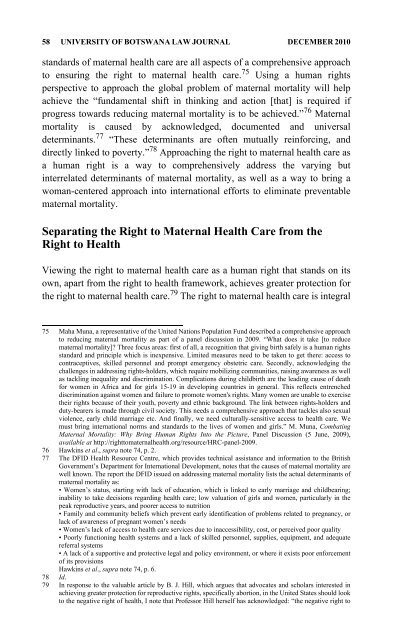University of Botswana Law Journal - PULP
University of Botswana Law Journal - PULP
University of Botswana Law Journal - PULP
You also want an ePaper? Increase the reach of your titles
YUMPU automatically turns print PDFs into web optimized ePapers that Google loves.
58 UNIVERSITY OF BOTSWANA LAW JOURNAL DECEMBER 2010<br />
standards <strong>of</strong> maternal health care are all aspects <strong>of</strong> a comprehensive approach<br />
to ensuring the right to maternal health care. 75 Using a human rights<br />
perspective to approach the global problem <strong>of</strong> maternal mortality will help<br />
achieve the “fundamental shift in thinking and action [that] is required if<br />
progress towards reducing maternal mortality is to be achieved.” 76 Maternal<br />
mortality is caused by acknowledged, documented and universal<br />
determinants. 77 “These determinants are <strong>of</strong>ten mutually reinforcing, and<br />
directly linked to poverty.” 78 Approaching the right to maternal health care as<br />
a human right is a way to comprehensively address the varying but<br />
interrelated determinants <strong>of</strong> maternal mortality, as well as a way to bring a<br />
woman-centered approach into international efforts to eliminate preventable<br />
maternal mortality.<br />
Separating the Right to Maternal Health Care from the<br />
Right to Health<br />
Viewing the right to maternal health care as a human right that stands on its<br />
own, apart from the right to health framework, achieves greater protection for<br />
the right to maternal health care. 79 The right to maternal health care is integral<br />
75 Maha Muna, a representative <strong>of</strong> the United Nations Population Fund described a comprehensive approach<br />
to reducing maternal mortality as part <strong>of</strong> a panel discussion in 2009. “What does it take [to reduce<br />
maternal mortality]? Three focus areas: first <strong>of</strong> all, a recognition that giving birth safely is a human rights<br />
standard and principle which is inexpensive. Limited measures need to be taken to get there: access to<br />
contraceptives, skilled personnel and prompt emergency obstetric care. Secondly, acknowledging the<br />
challenges in addressing rights-holders, which require mobilizing communities, raising awareness as well<br />
as tackling inequality and discrimination. Complications during childbirth are the leading cause <strong>of</strong> death<br />
for women in Africa and for girls 15-19 in developing countries in general. This reflects entrenched<br />
discrimination against women and failure to promote women's rights. Many women are unable to exercise<br />
their rights because <strong>of</strong> their youth, poverty and ethnic background. The link between rights-holders and<br />
duty-bearers is made through civil society. This needs a comprehensive approach that tackles also sexual<br />
violence, early child marriage etc. And finally, we need culturally-sensitive access to health care. We<br />
must bring international norms and standards to the lives <strong>of</strong> women and girls.” M. Muna, Combating<br />
Maternal Mortality: Why Bring Human Rights Into the Picture, Panel Discussion (5 June, 2009),<br />
available at http://righttomaternalhealth.org/resource/HRC-panel-2009.<br />
76 Hawkins et al., supra note 74, p. 2.<br />
77 The DFID Health Resource Centre, which provides technical assistance and information to the British<br />
Government’s Department for International Development, notes that the causes <strong>of</strong> maternal mortality are<br />
well known. The report the DFID issued on addressing maternal mortality lists the actual determinants <strong>of</strong><br />
maternal mortality as:<br />
• Women’s status, starting with lack <strong>of</strong> education, which is linked to early marriage and childbearing;<br />
inability to take decisions regarding health care; low valuation <strong>of</strong> girls and women, particularly in the<br />
peak reproductive years, and poorer access to nutrition<br />
• Family and community beliefs which prevent early identification <strong>of</strong> problems related to pregnancy, or<br />
lack <strong>of</strong> awareness <strong>of</strong> pregnant women’s needs<br />
• Women’s lack <strong>of</strong> access to health care services due to inaccessibility, cost, or perceived poor quality<br />
• Poorly functioning health systems and a lack <strong>of</strong> skilled personnel, supplies, equipment, and adequate<br />
referral systems<br />
• A lack <strong>of</strong> a supportive and protective legal and policy environment, or where it exists poor enforcement<br />
<strong>of</strong> its provisions<br />
Hawkins et al., supra note 74, p. 6.<br />
78 Id.<br />
79 In response to the valuable article by B. J. Hill, which argues that advocates and scholars interested in<br />
achieving greater protection for reproductive rights, specifically abortion, in the United States should look<br />
to the negative right <strong>of</strong> health, I note that Pr<strong>of</strong>essor Hill herself has acknowledged: “the negative right to
















